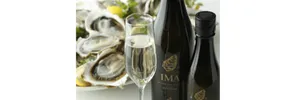


Takashi
Italian in Akihabara (2)
The second sake at an Italian restaurant in Akihabara with a customer was Black Imadaiji!
I've had Imadaiji before, but this was my first time to drink black sake!
From the appearance of the black sake and the word "Dai-harakuchi" (very dry), I thought..,
It's clear and dry? It's a bit dry, but it also has a bit of sweetness?
It's softer than I expected (or imagined).
I'm still not in my right mind and there is a possibility that my taste buds are not right 🤣.
Japanese>English








































